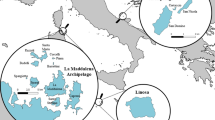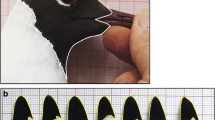Abstract
Size assortative mating has received increasing attention due to its potential to drive divergence and perhaps speciation. In this study, we examined assortative pairing at 17 nests of Darwin’s Small Tree Finches, Camarhynchus parvulus. We found positive assortative pairing for two traits: bill length and tarsus length, and these traits showed a significant positive correlation to each other. Assortative pairing could be driven by female choice for similar phenotypes because male–male competition has rarely been observed in the Small Tree Finch, nor have males been observed to reject potential mates. Given the high heritability of bill morphology in Darwin’s finches, it is possible that female preference for male bill length, a trait that is known to be important for foraging, will influence offspring bill size to maximise efficient exploitation of resources. The finding of size assortative pairing on the basis of tarsus length requires more research, but suggests different trait utilities for different foraging niches. Interestingly, the highland distribution of tarsus length across the population showed a unimodal distribution, but a bimodal distribution after pairing. While not significant, we found comparatively large differences across study plots in tarsus length, which suggests the possibility of phenotype–habitat matching at a small spatial scale in this species. Our findings are significant in the context of the adaptive radiation of Darwin’s finches as they are consistent with the allopatric model of speciation but also show potential for adaptive divergence in sympatry in Darwin’s tree finches.




Similar content being viewed by others
References
Abbott I, Abbott LK, Grant PR (1975) Seed selection and handling ability of four species of Darwin’s Finches. Condor 77:332–335
Abbott IJ, Abbott LK, Grant PR (1977) Comparative ecology of Galapagos ground finches (Geospiza Gould): evaluation of the importance of floristic diversity and interspecific competition. Ecol Monogr 47:151–184
Andersson S, Örnborg J, Andersson M (1998) Ultraviolet sexual dimorphism and assortative mating in blue tits. Proc R Soc Lond B 265:445–450
Bateson P (1983) Mate Choice. Cambridge University Press, Cambridge
Bearhop S, Fiedler W, Furness RW, Votier SC, Waldron S, Newton J, Bowen GJ, Berthold P, Farnsworth K (2005) Assortative mating as a mechanism for rapid evolution of a migratory divide. Science 310:502–504
Blondel J, Thomas DW, Charmantier A, Perret P, Bourgault P, Lambrechts MM (2006). A thirty-year study of phenotypic and genetic variation of Blue Tits in Mediterranean habitat mosaics. Bioscience 56:661–763
Boag PT (1983) The heritability of external morphology in Darwin’s ground finches (Geospiza) on Isla Daphne Major, Galápagos. Evolution 37:877–894
Boag PT, Grant PR (1978) Heritability of external morphology in Darwin’s finches. Nature 274:793–794
Boag PT, Grant PR (1984) Darwin’s finches (Geospiza) on Isla Daphne Major, Galapagos: breeding and feeding ecology in a climatically variable environment. Ecol Monogr 54:463–489
Bortolotti GR, Iko WM (1992) Non-random pairing in American kestrels: mate choice versus intra-sexual competition. Anim Behav 44:811–821
Bowman RI (1961) Morphological differentiation and adaptation in the Galapagos Finches. Palais des Academies, Brussels
Brown WD (1990) Size-assortative mating in the blister beetle Lytta magister (Coleoptera: Meloidae) is due to male and female preference for larger mates. Anim Behav 40:901–909
Burley N (1983) The meaning of assortative mating. Ethol Sociobiol 4:191–203
Christensen R, Kleindorfer S, Robertson JGM (2006) Song is a reliable signal of bill morphology in Darwin’s Small Tree Finch, Camarhynchus parvulus, and vocal performance predicts male pairing success. J Avian Biol 37:617–624
Colom R, Aluja-Fabregat A, Garcia-Lopez O (2002) Assortative mating in intelligence, psychoticism, extraversion, and neuroticism. Psicothema 14:154–158
Coyne JA, Orr HA (2004) Speciation. Sinauer, Sunderland
Davies NB, Halliday TR (1977) Optimal mate selection in the toad Bufo bufo. Nature 269:56–58
Delestrade A (2001) Sexual size dimorphism and positive assortative mating in Alpine Choughs (Pyrrhocorax graculus). Auk 118:553–556
Dieckmann U, Doebeli M (2004). Adaptive dynamics of speciation: sexual populations In: Dieckmann U, Doebeli M, Metz JAJ, Tautz D (eds) Adaptive speciation. Cambridge University Press, Cambridge, pp 76–111
Dieckmann U, Metz JAJ, Doebeli M, Tautz D (2004) Introduction. In: Dieckmann U, Doebeli M, Metz JAJ, Tautz D (eds) Adaptive speciation. Cambridge University Press, Cambridge, pp 1–16
Doebeli M (2005) Adaptive speciation when assortative mating is based on female preference for male marker traits. J Evol Biol 18:1587–1600
Forstmeier W, Keßler A (2001) Morphology and foraging behaviour of Siberian Phylloscopus warblers. J Avian Biol 32:127–138
Grant PR (1981) Speciation and the adaptive radiation of Darwin’s finches. Am Sci 69:653–663
Grant PR (1999) Ecology and evolution of Darwin’s finches. Reprint Edition. Princeton UniversityPress, Princeton
Grant BR, Grant PR (1989) Evolutionary dynamics of a natural population: the large Cactus Finch of the Galápagos. The University of Chicago Press, Chicago
Grant BR, Grant PR (1996) Cultural evolution of song and its role in the evolution of Darwin’s finches. Evolution 50:2471–2487
Grant PR, Grant BR (1997) Hybridization, sexual imprinting, and mate choice. Am Nat 149:1–28
Grant PR, Grant BR (2002a) Unpredictable evolution in a 30 year study of Darwin’s finches. Science 296:707–711
Grant PR, Grant BR (2002b) Adaptive radiation of Darwin’s Finches. Am Sci 90:130–139
Grant PR, Grant BR, Smith JNM, Abbott IJ, Abbott LK (1976) Darwin’s finches: population variation and natural selection. Proc Natl Acad Sci USA 73:257–261
Gustaffson L (1988) Foraging behaviour of individual coal tits, Parus ater, in relation to their age, sex and morphology. Anim Behav 36:696–704
Gutiérrez G, Luddecke H (2002) Mating pattern and hatching success in a population of the Andean frog Hyla labialis. Amphib-Reptil 23:281–292
Harari AR, Handler AM, Landolt PJ (1999) Size-assortative mating, male choice and female choice in the curculionid beetle Diaprepes abbreviatus. Anim Behav 58:1191–1200
Houtman AM, Falls JB (1994) Negative assortative mating in the white-throated sparrow, Zonotrichia albicollis: the role of mate choice and intra-sexual competition. Anim Behav 48:377–383
Jawor JM, Linville SU, Beall SM, Breitwisch R (2003) Assortative mating by multiple ornaments in northern cardinals (Cardinalis cardinalis). Behav Ecol 14:515–520
Kawecki TJ (2004) Genetic theories of sympatric speciation. In: Dieckmann U, Doebeli M, Metz JAJ, Tautz D (eds) Adaptive speciation. Cambridge University Press, Cambridge, pp 36–53
Kirkpatrick M (2000) Reinforcement and divergence under assortative mating. Proc R Soc Lond B 267:1649–1655
Kleindorfer S, Chapman TW, Winkler H, Sulloway FJ (2006) Adaptive divergence in contiguous populations of Darwin’s small ground finch (Geospiza fuliginosa). Evol Ecol Res 8:357–372
Kleindorfer S (2007a) Nesting success in Darwin’s Small Tree Finch (Camarhynchus parvulus): evidence of female preference for older males and more concealed nests. Anim Behav (In press)
Kleindorfer S (2007b). The ecology of clutch size variation in Darwin’s Small Ground Finch, Geospiza fuligniosa: comparison between low- and highland habitats. Ibis (In press)
Komdeur J, Oorebeek M, van Overveld T, Cuthill IC (2005) Mutual ornamentation, age, and reproductive performance in the European starling. Behav Ecol 16:805–817
Kondrashov AS, Shpak M (1998) On the origins of species by means of assortative mating. Proc R Soc Lond B 265:2273–2278
Lack D (1947) Darwin’s finches: an essay on the general biological theory of evolution. Cambridge University Press, Cambridge
Landmann A, Winding N (1993) Niche segregation in high-altitude Himalayan chats (Aves, Turdidae): does morphology match ecology? Oecologia 95:506–519
McKaye KR (1986) Mate choice and size assortative pairing by the cichlid fishes of Lake Jiloa, Nicaragua. J Fish Biol 29:135–150
Miles DB, Ricklefs RE (1984) The correlation between ecology and morphology in deciduous forest passerine birds. Ecology 65:1629–1640
Nagel LM, Schluter D (1998) Body size, natural selection, and speciation in sticklebacks. Evolution 52:209–218
Ortíz-Barrientos D, Noor MAF (2005) Evidence for a one-allele assortative mating locus. Science 310:1467
Petren K, Grant RB, Grant PR (1999) Low extrapair paternity in the Cactus Finch (Geospiza scandens). Auk 116:252–256
Price TD (1987) Diet variation in a population of Darwin’s finches. Ecology 68:11015–1028
Price TD (1991) Morphology and ecology of breeding warblers along an altitudinal gradient in Kashmir, India. J Anim Ecol 60:643–664
Ridley M (1983) The explanation of organic diversity: The comparative method and adaptations for mating. Clarendon, Oxford
Robertson JGM (1986) Female choice, male strategies and the role of vocalizations in the Australian frog Uperoleia rugosa. Anim Behav 34:773–784
Schluter D, Grant PR (1984) Determinants of morphological patterns in communities of Darwin’s finches. Am Nat 123:175–196
Shapiro BJ, Garant D, Wilkin TA, Sheldon BC (2006). An experimental test of the causes of small-scale phenotypic differentiation in a population of great tits. J Evol Biol 19:176–183
Shields WM (1982) Philopatry, inbreeding, and the evolution of sex. State University of New York, Albany
Tebbich S, Taborsky M, Fessl B, Dvorak M, Winkler H (2004) Feeding behavior of four arboreal Darwin’s Finches: adaptations to spatial and seasonal variability. Condor 106:95–105
Thomas F, Oget E, Gente P, Desmots D, Renaud F (1999) Assortative pairing with respect to parasite load in the beetle Timarcha maritima (Chrysomelidae). J Evol Biol 12:385–390
Van Alphen JJM, Seehausen O, Galis F (2004). Speciation and radiation in African Haplochromine cichlids. In: Dieckmann U, Doebeli M, Metz JAJ, Tautz D (eds) Adaptive Speciation. Cambridge University Press, Cambridge, pp 173–191
van Oppen MJH, Turner GF, Robinson CRRL, Deutsch JC, Genner MJ, Hewitt GM (1998) Assortative mating among rock-dwelling cichlid fishes supports high estimates of species richness from Lake Malawi. Mol Ecol 7:991–1001
Acknowledgments
We thank the Galapagos National Park Service and the Charles Darwin ResearchStation for the opportunity to work on the Galapagos Archipelago, and TAMEairlines for reduced airfare. This study was funded by the Austrian Academyof Sciences (2000–2002) and the Flinders University Establishment Grant (2004–2005) with awards to SK. We are grateful to Jeremy Robertson, Margot Oorebeek and two anonymous reviewers for critical comments on an earlier version of this manuscript. This work would not have been possible without the dedicated field assistance by Santiago Torres and Carlos Vinueza. All work followed the Guidelines for the Use of Animals in Research (Flinders University, Charles Darwin Research Station, Galapagos National Parks Service), met the legal requirements of Ecuador, and was approved by the Animal Welfare Committee of Flinders University (Permit E129).
Author information
Authors and Affiliations
Corresponding author
Additional information
Communicated by T. Friedl.
Rights and permissions
About this article
Cite this article
Christensen, R., Kleindorfer, S. Assortative pairing and divergent evolution in Darwin’s Small Tree Finch, Camarhynchus parvulus . J Ornithol 148, 463–470 (2007). https://doi.org/10.1007/s10336-007-0173-x
Received:
Revised:
Accepted:
Published:
Issue Date:
DOI: https://doi.org/10.1007/s10336-007-0173-x




